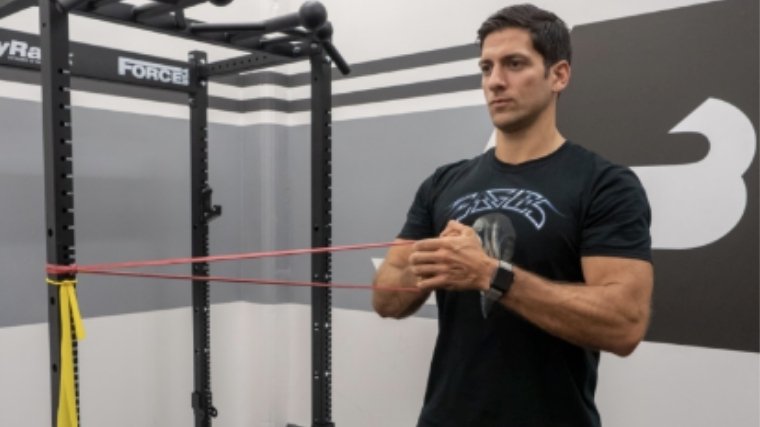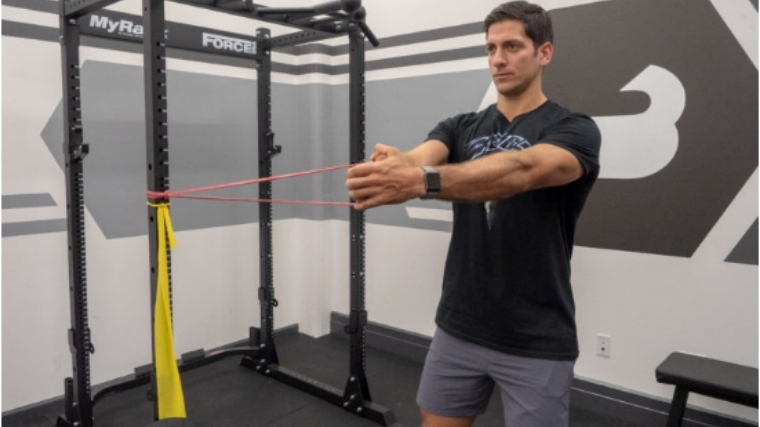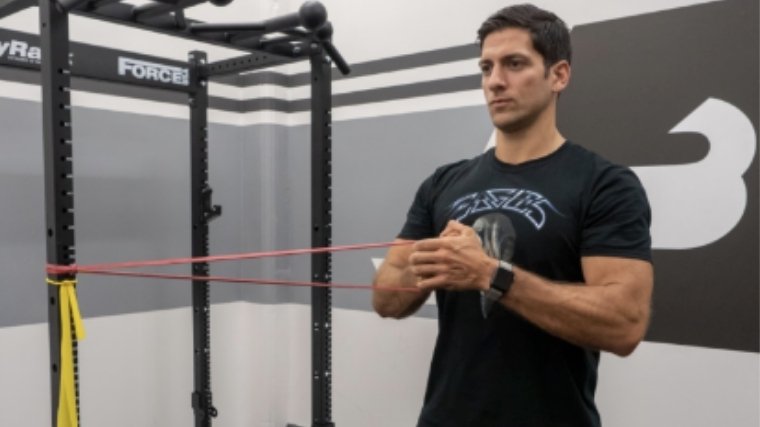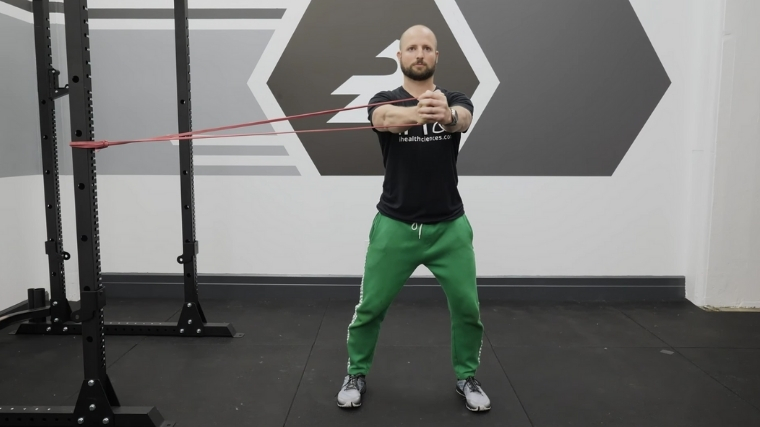Perfect the Pallof Press for More Core Strength and Stability
What exercises come to mind when you picture a chiseled six-pack? Crunches, sit-ups, maybe a plank? What about the Pallof press? Probably not, because the move sounds more like a piece of construction equipment rather than the ultimate core-building exercise — but it is, and you should be doing it.
The Pallof press has a lifter hold a taut resistance band (or cable) in front of them and slowly press it out and back. The band’s tension pulls the lifter toward the anchor point, so they must utilize their core to its fullest extent to stay in place. Compared to other ab exercises, the Pallof press trains an athlete’s ability to stabilize under load.
This is important since you want to remain tight during loaded movements like the back squat and deadlift. The Pallof press is a legitimately functional exercise and one worth learning.
- How to Do the Pallof Press
- Pallof Press Sets and Reps
- Common Pallof Press Mistakes
- Pallof Press Variations
- Pallof Press Alternatives
- Muscles Worked by the Pallof Press
- Benefits of the Pallof Press
- Who Should Do the Pallof Press
- Frequently Asked Questions
Editor’s Note: The content on BarBend is meant to be informative in nature, but it shouldn’t take the place of advice and/or supervision from a medical professional. The opinions and articles on this site are not intended for use as diagnosis, prevention, and/or treatment of health problems. Speak with your physician if you have any concerns.
How to Do the Pallof Press
Below is a step-by-step guide on how to properly set up and perform the Pallof press.
Step 1 —Establish Proper Alignment
Start by looping a resistance band around a power rack (or any stable anchor point) at chest height. Grab the free end of the band in both hands, and stand perpendicular to the anchor point. Interlock your fingers and hold the band right at your chest. Step away from the anchor point so that there is tension on the band.
Coach’s Tip: You want to be in an athletic stance, with a slight bend in your knees and your chest up.
Step 2 — Press Forward
Now, squeeze your hands together and straighten your fingers. You should be clasping the band tightly with your palms. Ensure that your shoulder blades are squeezed together (so that your shoulders don’t track forward), and extend your arms. You will feel the band pull you toward the anchor point.
The goal is not to let your torso twist — and it’s this anti-rotation that will strengthen your core muscles.
Coach’s Tip: Be sure to keep the shoulders close to the body without rotating the hips and fighting the band’s rotational forces.
Step 3 — Pull Your Hands Back
Keeping your abs flexed and your shoulder blades retracted, slowly return the band to your chest. You can make this exercise harder in two ways. The first is to move further away from the anchor point, which will increase the tension on the band. You can only do that for so long, however.
The second way is to use a thicker band. Or, if you’re using a cable machine, simply up the weight on the stack. That said, the Pallof isn’t an exercise you want to overload too much, so increase the resistance within reason and then perform the move for more reps or time.
Coach’s Tip: Be sure not to let the torso or shoulders slouch forwards.
Pallof Press Sets and Reps
The "smaller" the exercise, the fewer options you tend to have when it comes to programming. The Pallof press isn’t a mallet, it’s a scalpel — meaning you can’t hammer away at it and expect to make crazy strength gains or grow pounds and pounds of muscle.
That said, in the right contexts, it can be an invaluable tool in your toolkit.
- As a Prehab Tool: Try out 2 or 3 sets of 10 to 15 reps per side before your workout proper.
- For Core Strength: Shoot for 3 to 4 sets of up to 10 reps with a heavier band and more tension.
- To Learn Technique: Perform 5 sets of 5 reps with a very slow and controlled tempo.
Common Pallof Press Mistakes
It may not be as intricate as a snatch or power clean, but the Pallof press can still go wrong. Be mindful of these errors before you start performing the exercise.
Torso Twisting
The Pallof press is an isometric exercise for your core. It teaches you specifically to resist any unwanted side-to-side movement. As such, you should avoid bending or twisting at the torso or hips at all costs, as it defeats the purpose of the exercise.
Not Pressing Straight
As you push your hands outward, it will become more and more tempting to drift them toward the side that the band is fixed on. This will take tension off your trunk and make the movement easier. Take great care to ensure you’re pressing your fists in a straight line from start to finish.
Standing Too Close (or Too Far)
If you opt to work the Pallof press with a resistance band, it will probably take some trial and error to find the right amount of tension. If you stand too close to the fixture, you won’t get any stimulation to your core or shoulders. Stand too far, and the exercise will be too difficult to complete with proper form.
Pallof Press Variations
Below are three Pallof press variations of varying difficulties that beginners, intermediate, and advanced lifters can use to progress or regress their training.
Half-Kneeling Pallof Press
The half-kneeling Pallof press allows beginner and intermediate athletes to anchor the pelvis and maintain a tall and proud posture. This is often one of the first progressions used with beginners as it’s generally easier to do.
Double Kneeling Pallof Press
This is a simple progression upon the standing version, which will have an individual be down on both knees. This will slightly increase the demands placed upon the core muscles, as the lifter won’t be as stable as they are on two feet.
Pallof Press with Overhead Reach
This variation adds an overhead reach following the Pallof press. To do this, simply raise your hands (with the resistance band or cable handle in them) slowly overhead following the standard Pallof press. Be sure to keep the ribs and belly button pulled down and in towards the body to remain in proper spinal alignment.
Pallof Press Alternatives
The exercise has plenty of alluring benefits, but you may not want to perform the Pallof press at all. In that case, you give these similar movements a go and reap many of the same rewards.
Bird Dog Row
The bird dog and the bird dog row are two core stability exercises that can increase core stabilization and educate individuals on aligning the spine and contracting the core during pulling and reaching movements. Simply put: it strengthens your core and improves your form.
Landmine Rotation
The landmine rotation is a dynamic core stability exercise that also reinforces scapular stability. This is a great anti-rotational exercise for athletes and anyone looking to promote hip rotation and force transfer necessary for more functional movements.
Front-Loaded Carry
Front-loaded carries, whether it is kettlebell front rack walks or sandbag carries, are great core strengthening exercises for all lifters and individuals. Front-loaded work increases core strength, demands (and therefore improves) good posture, and reinforces proper ribcage positioning.
Muscles Worked by the Pallof Press
Below are the muscles that the Pallof press works. The Pallof press is a full-body exercise that can increase overall stability and activate many large muscle groups in the body (discussed below).
Obliques
The obliques are challenged isometrically to resist rotation, often responsible for shearing forces placed on the lumbar spine. The exercise’s anti-rotational properties make it pivotal for most athletes — who often rotate to throw and catch a ball, swing a club or bat, and juke and sprint to evade an opponent.
Transverse Abdominals
The transverse abdominals (often targeted through plank variations) are targeted at a slightly different angle in the Pallof press. Since you have to pay a great deal of attention to your pelvic tilt and rigidity, you’ll notice a lot of engagement in your transverse abdominis throughout.
Scapular Stabilizers
A key to properly doing the Pallof press is keeping your shoulder blades squeezed together. All the small muscles in and around your shoulder blades work hard to hold this position. While you may not gain any aesthetics from stronger scapular stabilizers, they can help you maintain better posture and a neutral spine during heavy lifts. So, yes, they’re important.
Gluteals
It’s no coincidence that "squeeze your glutes" is a cue for just about every exercise. Stand up (unless you’re already standing) and squeeze your butt right now (seriously). Did you feel your legs light up, and did your knees rotate outward?

Yes, and that’s a stronger foundation for every move from the front squat press to the overhead press. By keeping your glutes tight throughout the Pallof press, you’ll enhance your foundational strength for all other lifts.
Rectus Abdominis
While the Pallof press does not entail flexion and extension of the spine, it demands spinal stabilization and anti-rotational abilities from the core. The rectus abdominis — to six-pack muscles — contracts isometrically to assist in spinal stabilization during this movement.
Benefits of the Pallof Press
Below are three main benefits of integrating the Pallof press into your training routine.
It’s Great for Movement Prep
The Pallof press is a great way to prime the body for lifting or athletic movements. For one, your body is tense for the entirety of the move — so you’re actively engaging your glutes, core, and legs (which work to keep you grounded and stable). And as you push and pull the band, your upper back muscles and shoulders will warm up. The Pallof press is a core movement, but it does engage your entire body.
It Trains Anti-Rotational Strength
An athlete needs to be able to rotate explosively to run and throw, but they also need to stop that movement — and that’s what anti-rotation is. A car accelerates to gain speed but then brakes to stop. The Pallof press teaches you how to put on the brakes.
Even if you’re not actively rotating, your body experiences rotation — even minimally — during moves like pull-ups, deadlifts, squats, and more. Being able to resist that rotation is what will keep you stable during those lifts. Stability is important to maintain good form, making you a more efficient lifter and a safer one.
It Helps Build Your Six-Pack
A sharper six-pack is part of the draw of any good core exercise. However, it’s important to understand that your abs are like any other muscle on your body — you won’t see them unless they’re bigger and you’re leaner. Assuming your diet is in check, then, yes, the Pallof press provides enough muscular stress to build up your six-pack.
Who Should Do the Pallof Press
The Pallof press is a valuable movement prep and core strengthening exercise for nearly every lifter. It helps to establish proper spinal alignment under load and increase core stability. Below we will discuss what types of athletes can benefit from the Pallof press and why.
Strength and Power Athletes
The more stable and rigid you are during heavy lifts, the more efficient you’ll be. Maintaining proper bracing and spinal alignment requires awareness, but it also takes a strong core — which is how the Pallof press can help strength athletes.
For strength-minded gymgoers, improving core stability will help enhance force output and decrease injury risks when placing heavy loads on the spine or performing loaded carries.
Functional Fitness Athletes
The Pallof press can enhance posture, core activation, and stability and help athletes develop greater muscle coordination control during movements in the gym, on the track/field, and in life. Building a strong core and minimizing excessive strain on the lumbar spine is key to longevity, essential for long-term career athletes and continued progress.
General Populations
Bracing is essential to staying tight during heavy lifts, yet many gymgoers don’t know how to brace properly. The Pallof press is a great beginner exercise to help develop the ability to control muscle contractions of the core, develop greater self-awareness of spinal alignment, and enhance posture and spinal health under load or during training.
Press the Issue
Crunches can be as boring as all get-out, but shredded abs are cool — and so is being strong. Fortunately, the Pallof press lets you hit two birds with the same stone, without forcing you onto the yoga mats for endless sets of sit-ups.
If you want a structurally sound and well-developed midsection, you need to train your abs not only to create movement, but to resist it. The Pallof press teaches this skill and more in spades. Plug it into your next ab workout and see for yourself.
FAQs
Still have some lingering questions about the Pallof press? No problem.
Can I do a Pallof press without a resistance band?
Yes, you can do Pallof presses with a cable machine. You need lateral resistance to do the movement, so you can’t use kettlebells, dumbbells, or weight plates.
When Should I do the Pallof press?
You can do the Pallof press either before or after your workout. To do it before you train, as a warm-up, use less resistance and do fewer sets and reps. You don’t want to fatigue your core before heavy lifts — this will just ensure your form is off.
Or, you can perform the Pallof press at end of your workout to tax your core. Use more resistance and perform more sets and reps if this is your goal.
Can I do the Pallof press if I have lower back pain?
Always consult your doctor prior to starting any fitness or rehab program. That said, the Pallof press doesn’t directly tax your lower back, so you should be ok. Aso, the anti-rotational skills and ability to brace more effectively may actually help you protect yourself from back injuries in the future.
{"@context":"https://schema.org","@type":"FAQPage","mainEntity":[{"@type":"Question","name":"Can I do a Pallof press without a resistance band?","acceptedAnswer":{"@type":"Answer","text":"
Yes, you can do Pallof presses with a cable machine. You need lateral resistance to do the movement, so you can’t use kettlebells, dumbbells, or weight plates.u00a0u00a0
"}},{"@type":"Question","name":"When Should I do the Pallof press?","acceptedAnswer":{"@type":"Answer","text":"
You can do the Pallof press either before or after your workout. To do it before you train, as a warm-up, use less resistance and do fewer sets and reps. You don’t want to fatigue your core before heavy lifts u2014 this will just ensure your form is off.
Or, you can perform the Pallof press at end of your workout to tax your core. Use more resistance and perform more sets and reps if this is your goal.
"}},{"@type":"Question","name":"Can I do the Pallof press if I have lower back pain?","acceptedAnswer":{"@type":"Answer","text":"
Always consult your doctor prior to starting any fitness or rehab program. That said, the Pallof press doesn’t directly tax your lower back, so you should be ok. Aso, the anti-rotational skills and ability to brace more effectively may actually help you protect yourself from back injuries in the future.
"}}]}
Deja una respuesta





►Te puede interesar...